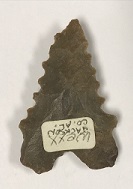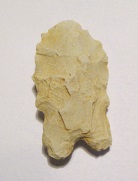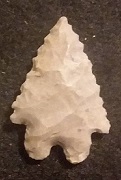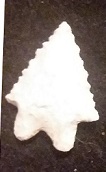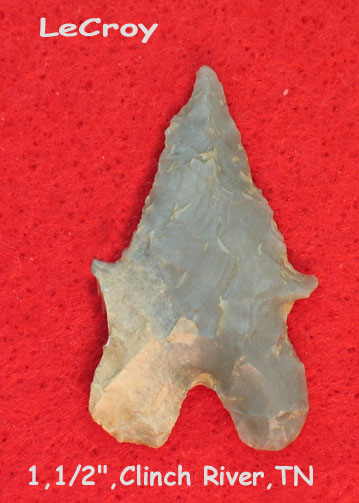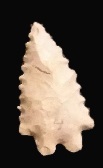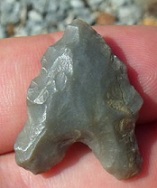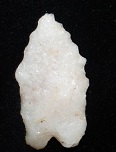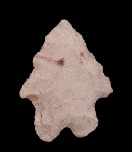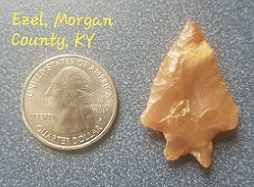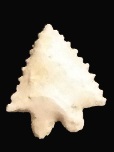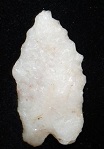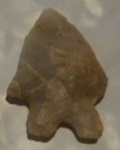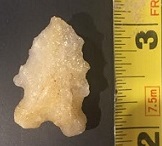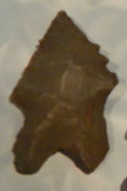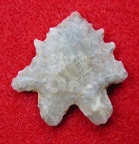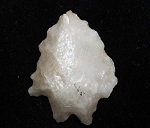Outline is Representative of Size and Shape:

Name Details:
Identified By: Madeline Kneberg
Named For: Type Site
Date Identified: 1956
Type Site: A. L. LeCroy Site, Hamilton County, Tennessee
Identified By: Madeline Kneberg
Named For: Type Site
Date Identified: 1956
Type Site: A. L. LeCroy Site, Hamilton County, Tennessee
Point Validity:
Valid type
Kneberg was a prominent anthropologist and professor at the University of Tennessee. She is most recognized for her excavations through-out the Tennessee River Valley. This type was named in a professional publication and has many professional references. This is considered a valid type.
LeCroy Bifurcated
Cluster: LeCroy Cluster Description of Physical Characteristics and Flaking Pattern:
This is a thin small (typically 1 to 1.5 inches) triangular bifurcated point with a thin elliptical cross section. The blade is short and stubby and primarily straight, but may be slightly excurvate or incurvate on re-sharpened examples. The blade is most commonly serrated and asymmetrical. The shoulders usually slope upwards, but may be horizontal. Many examples have irregular or asymmetrical shoulder barbs. The stem is long and commonly makes up one third to one half of the length of the point. The stem is broad and ranges from straight to expanding with a deeply bifurcated base. The auriculate are rounded and angled downward. Hafting region grinding or smoothing is commonly present. This point has a random flaking pattern and are manufactured using fine pressure flaking over percussion flaking.
Size Measurements:
Total Length - 19 to 53 mm (31 to 41 mm average), Stem Length - 9 to 17 mm (11 to 13 mm average, typically 1/3 to 1/2 the total length), Blade Width - 16 to 40 mm (22 to 28 mm average), Neck Width - 12 to 24 mm (average 16 to 19 mm), Stem Basal Width - 14 to 29 mm (average 19 to 23 mm), Thickness - 4 to 9 mm
Total Length - 19 to 53 mm (31 to 41 mm average), Stem Length - 9 to 17 mm (11 to 13 mm average, typically 1/3 to 1/2 the total length), Blade Width - 16 to 40 mm (22 to 28 mm average), Neck Width - 12 to 24 mm (average 16 to 19 mm), Stem Basal Width - 14 to 29 mm (average 19 to 23 mm), Thickness - 4 to 9 mm
Commonly Utilized Material:
Cherts, jasper, quartz, and quartzite with many examples using heat treatment.
Cherts, jasper, quartz, and quartzite with many examples using heat treatment.
Additional Comments:
Whatley (2002), notes that these are the smallest of the bifurcated types.
Broyles (1971), identify this point as the most common bifurcated point found in the eastern U.S.
The LeCroy point may be distinguished from the St. Albans and MacCorkle by the base. The LeCroy point has a straight stem while the MacCorkle and St. Albans points have more of a lobed base. (W10).
This point is similar to the St. Albans point. The shoulders on the LeCroy point are more pronounced while the shoulders on a St Albans point are weak to absent.
Whatley (2002), notes that these are the smallest of the bifurcated types.
Broyles (1971), identify this point as the most common bifurcated point found in the eastern U.S.
The LeCroy point may be distinguished from the St. Albans and MacCorkle by the base. The LeCroy point has a straight stem while the MacCorkle and St. Albans points have more of a lobed base. (W10).
This point is similar to the St. Albans point. The shoulders on the LeCroy point are more pronounced while the shoulders on a St Albans point are weak to absent.
Distribution: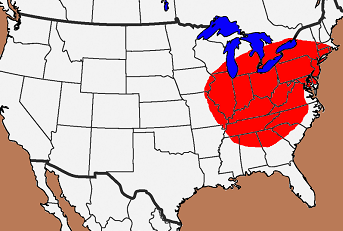

Distribution Comments:
These points are primarily associated with the Ohio River Valley and into Mid Mississippi River Valley, the Tennessee River Valley, and Piedmont of South and North Carolina and Virginia.
These points are primarily associated with the Ohio River Valley and into Mid Mississippi River Valley, the Tennessee River Valley, and Piedmont of South and North Carolina and Virginia.
Age / Periods:
Date: 8,500 - 7.800 B.P.
Cultural Period: Early Archaic
Glacial Period: Erly to Middle Holocene
Culture:
Date: 8,500 - 7.800 B.P.
Cultural Period: Early Archaic
Glacial Period: Erly to Middle Holocene
Culture:
Age Details:
Broyles (1971) notes that LeCroy points fall into a late Early Archaic period around 8,300 B.P.
Chapman (1985) places the LeCroy phase to between 8,500 and 7,800 B.P. in eastern Tennessee.
At the St. Albans site (Broyles 1971:69) in zones 6 and 8 and has been dated at 6300 B.C. 100 years (Broyles 1971:69). This date places the type later in time than the St. Albans Side Notched and earlier than the Kanawha Stemmed type (Harter, 1973)
Broyles (1971) notes that LeCroy points fall into a late Early Archaic period around 8,300 B.P.
Chapman (1985) places the LeCroy phase to between 8,500 and 7,800 B.P. in eastern Tennessee.
At the St. Albans site (Broyles 1971:69) in zones 6 and 8 and has been dated at 6300 B.C. 100 years (Broyles 1971:69). This date places the type later in time than the St. Albans Side Notched and earlier than the Kanawha Stemmed type (Harter, 1973)

